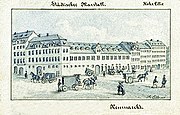Marstall (Leipzig)
The Marstall in Leipzig (also of the Rath Marstall or Städtischer Marstall ) was a historical institution of the City Council for the performance of communal transport tasks and services. The necessary horses, wagons and equipment were in the stables.
Location and shape
The Marstall was located from 1575 to 1867 at the southern end of Neumarkt (until 1839 Neuer Neumarkt) at the corner of Peterskirchhof . The property was a four-sided courtyard with gates from both adjoining streets. Along the Neumarkt a serving also for residential purposes two-story building covered with a Renaissance - gable above the entrance gate. It had more doors to the street, and in the courtyard a covered outside staircase led to the upper floor. The gable roof carried numerous dormers . The wing along the Peterskirchhof was one storey higher and had a hipped mansard roof .
Johann Jakob Vogel describes the Marstall in his Leipzig history book from 1756 as follows:
- The common buildings also include the large stone building on the Neumarckt / which is called the Marstall / EE RathsPferde / inside with which the associated items and wagons are kept. This building was built with the apartments / including stables and stately vaulted cellars / as well as the attached houses / in which the Ober-Voigt and the three Ausreuter or council servants have their apartments / according to the Leipzig Chronicle / Anno 1575. Before this is E. Ed. Raths Marstall in the Ritterstrasse / where itzo is the rothe Collegium / ...
history
Before he took his place on Neumarkt, the city stables were on a property on the east side of Ritterstrasse. This location was mentioned for 1426. When the Leipzig University was reformed at the beginning of the 16th century, Duke Georg ordered the construction of a new building for the artist faculty in 1502 , between the small and large Fürstenkolleg , the previous location of the Marstall. It later became the Red College . In return, the city received a plot of land at the southern end of the New Neumarkt for the space on Ritterstrasse. The completion of the stables at this point did not take place until 1575.
The stables as an institution had numerous tasks to perform. At the beginning of the 18th century, the "Unflat", which had previously been openly flowing off the streets, began to be diverted into canals under the street in the Pleißemühlgraben. The municipal stables were responsible for maintaining and cleaning this canal system. Around 1800 it was prescribed in Leipzig to sweep the street on Wednesdays and Saturdays and to throw the “excrement in piles, which is then driven by 12 one-horse carts (of the Marstall) to certain areas outside the city”; the royal stables were the forerunners of city cleaning.
In the course of building activity in downtown Leipzig in the second half of the 19th century, the Marstall building was demolished in 1867 and the site was parceled out . Residential and commercial buildings were built, some of which were demolished in 1912 for the construction of the Althoff department store .
literature
- Horst Riedel, Thomas Nabert (ed.): Stadtlexikon Leipzig from A to Z . 1st edition. Pro Leipzig, Leipzig 2005, ISBN 3-936508-03-8 , pp. 383 .
Web links
Individual evidence
- ↑ Gina Klank, Gernoth Griebsch: Encyclopedia Leipziger street names . Ed .: City Archives Leipzig. 1st edition. Verlag im Wissenschaftszentrum Leipzig, Leipzig 1995, ISBN 3-930433-09-5 , p. 135/136 .
- ↑ Johann Jakob Vogel: Leipzigisches Geschicht-Buch or Annales, That is: Years and Days Books ... Leipzig 1756, p. 169
- ^ Peter Schwarz: The millennial Leipzig. From the beginning to the end of the 18th century . 1st edition. tape 1 . Pro Leipzig, Leipzig 2014, ISBN 978-3-945027-04-2 , pp. 126 .
- ^ Peter Schwarz: The millennial Leipzig . Vol. 1, p. 208
- ^ Peter Schwarz: The millennial Leipzig . Vol. 1, p. 335
- ^ Friedrich Gottlob Leonhardi : History and description of the trading city Leipzig , Leipzig 1799, p. 388
Coordinates: 51 ° 20 ′ 15.4 " N , 12 ° 22 ′ 33.7" E


